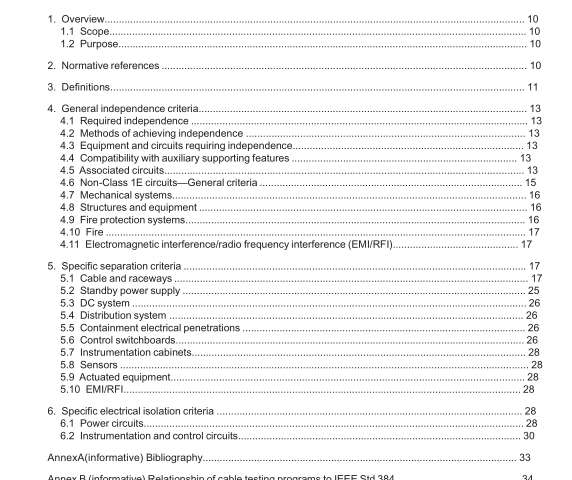IEEE 384-2018 pdf download.IEEE Standard Criteria for Independence of Class 1E Equipment and Circuits
4.5.2 Criteria Associated circuits shall comply with one of the following requirements:
a) They shall be uniquely identified as such, or as Class 1E, and shall remain with and be traceable to the associated Class 1E division; or be physically separated the same as those Class 1E circuits with which they are associated. They shall be subject to the requirements placed on Class 1E circuits, unless it can be demonstrated by analysis or testing that the absence of such requirements cannot degrade the Class 1E circuits below an acceptable level.
b) They shall be in accordance with item a) of this subclause from the Class 1E equipment to and including an isolation device. Beyond the isolation device, such a circuit is non-Class 1E provided that it does not again become associated with a Class 1E circuit.
c) They shall be analyzed or tested to demonstrate that Class 1E circuits are not degraded below an acceptable level. These associated circuits can then be considered non-Class 1E circuits per the requirements of items c), d), e), and f) in 4.6. Preferred power supply circuits from the transmission network and those similar power supply circuits from the unit generator that become associated circuits solely by their connection to the Class 1E distribution system input terminals are exempt from the requirements for associated circuits.
4.5.3 Qualification requirements
Associated circuits, including their isolation devices or the connected loads without the isolation devices, shall be subject to the qualification requirements placed on Class 1E circuits to help ensure that the Class 1E circuits are not degraded below an acceptable level. Associated circuits need not be qualified for performance of function, since the function is non-Class 1E.
4.6 Non-Class 1E circuits—General criteria The independence of non-Class 1E circuits from Class 1E circuits or associated circuits shall be achieved by complying with the following requirements:
a) Non-Class 1E circuits shall be physically separated from Class 1E circuits and associated circuits by the minimum separation requirements specified in 5.1.3, 5.1.4, 5.1.5, 5.1.9, or 5.6, except as permitted in items c), d), and e) in 4.6, or the non-Class 1E circuits shall be associated circuits. (See Figure 2.)
b) Non-Class 1E circuits shall be electrically isolated from Class 1E circuits and associated circuits by the use of isolation devices, shielding, and wiring techniques or separation distance, except as permitted in items c), d), e), and f) in 4.6, or the non-Class 1E circuits shall be associated circuits. (See Figure 1, Figure 3, and Figure 8.)
c) The effects of less than minimum separation or the absence of electrical isolation between the non- Class 1E circuits and the Class 1E circuits or associated circuits shall be analyzed to demonstrate that Class 1E circuits are not degraded below an acceptable level, or the non-Class 1E circuits shall be associated circuits. As part of the analysis, consideration shall be given to potential energy and identification of the circuits involved.Also, the non-Class 1E circuits shall remain with the division to which it was analyzed and shall not be routed with other divisions.
d) Non-Class 1E instrumentation signal and control circuits (see IEEE Std 690™) are not required to be physically separated or electrically isolated from associated circuits provided that: 1) The non-Class 1E circuits are not routed with other divisions. 2) The non-Class 1E circuits are analyzed to demonstrate that Class 1E circuits are not degraded below an acceptable level. As part of the analysis, consideration shall be given to potential energy and identification of the circuits involved.
e) Non-Class 1E fiber-optic circuits are not required to be physically separated from Class 1E and associated circuits. Electrical isolation is an inherent characteristic of fiber-optic circuits. Because fiber-optic circuits have no potential to degrade Class 1E circuits, they can be considered non-Class 1E circuits versus associated circuits.
f) Non-Class 1E circuits used exclusively to mitigate BDBEEs may be electrically isolated from Class 1E circuits and associated circuits by the use of administratively controlled Class 1E circuit interrupting devices located in safety class structures as shown in Figure 1.IEEE 384 pdf download.IEEE 384-2018 pdf download
IEEE 384-2018 pdf download

Leave a Reply